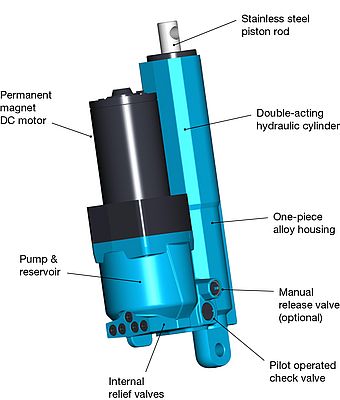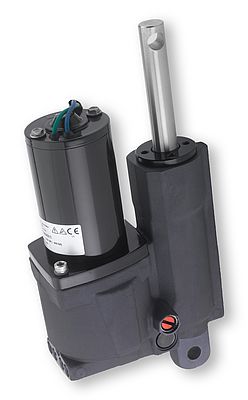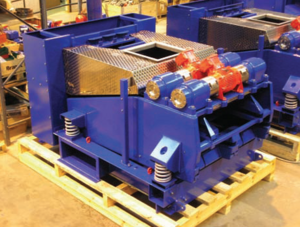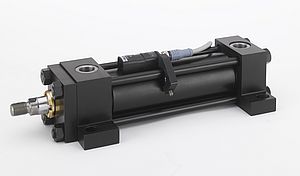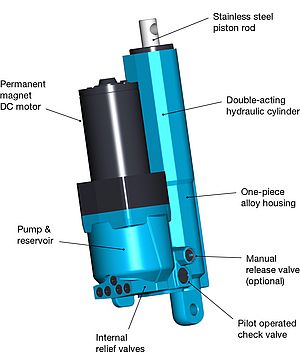Electro-hydraulics –combining hydraulics and electronics - can offer an alternative to the traditional options based on hydraulic, pneumatic or electromechanical technologies for moving, lifting, turning and holding
Moving, lifting, turning and holding are crucial functions of almost all types of industrial machinery in a wide range of applications. Simple assembly operations equipment to fully integrated process lines, and construction and agricultural equipment to power stations and offshore wind farms all feature some form of linear, rotary or reciprocating motion.
Traditionally, the options available to engineers have been based on established hydraulic, pneumatic or electromechanical technologies. Now, through an innovative combination of hydraulics and electronics, there is a fourth option emerging known as electro-hydraulics. This approach provides a viable solution when the application demands a compact, high power, stand-alone method of motion control.
Established approaches
Modern hydraulics are an efficient, controllable and extremely effective method of delivering high levels of force but, in more complex systems, require an infrastructure of supporting pipework and power units. Similarly, pneumatics technology can be ideal for lower duty applications but is limited in the power available and, again, requires a support infrastructure. Electromechanical systems are perceived to be clean and efficient but generally require cumbersome motors and potentially costly control devices, with additional gearing mechanisms being needed if heavy loads are to be moved or high forces to be achieved.
Pneumatics and electro-mechanics have undergone a major evolution in recent years, with the latest automation and production systems being smaller and requiring less power than before. Primarily, these advances have been driven by an increasing demand for higher levels of precision and repeatability in all kinds of machine systems. By comparison, hydraulics technology has become an automatic choice for lifting, holding and controlling large loads, and for moving heavy objects at slow speeds or applying torque without the need for gearing or braking. It is also widely used in mobile, off-highway and other applications where there is no fixed power infrastructure, offering an ideal solution especially when high performance and reliable power delivery are critical.
Recent developments by companies such as Parker have included ways to extend the potential use of hydraulics technology, through improved levels of control, lower weight and noise, and greater functionality. This scope of this challenge has included extending the traditional spectrum of hydraulics use to meet the needs of both advanced and simpler, less industrialised applications.
Electronic control
Traditionally, the configuration of hydraulic systems has been seen as a specialised operation, due for example to the complexity of handling asymmetric functions such as the extension and retraction of pistons. In recent years, however, there have been considerable developments in electronic control for devices such as valves and cylinders, which simplify system design, setup, programming and operation.
As a result, modern hydraulics, especially in demanding industrial and mobile applications, now incorporate dedicated PID controls with advanced algorithms that ensure predictive and multivariable functionality with precise and repeatable high speed motion. Additionally, these systems are often fitted with sophisticated sensors and controllers for functions such as position feedback, for both position and speed detection, and force feedback for determining applied load, active damping and compliant motion.
This level of sophistication and control is not, however, appropriate in all applications. For example, mobile and military equipment often requires high levels of power and precision, but with a simple control system that is easy to install, operate and maintain; system reliability and a long, trouble-free operating life under demanding conditions being more important than the ability to deliver positioning to the nearest few microns.
In addition, many of these applications require high levels of force, but also demand that component or system size and weight be minimised. In other words, they require technology that offers a high power density, ideally in a self-contained, simple to use and reliable package.
Electro-hydraulics
Electro-hydraulic approaches such as Compact EHA from Parker can offer an effective solution in this space. These double-acting actuators integrate all essential component parts including the hydraulic actuator, a reversible gear pump and either a 12V or 24V DC motor, in a robust monobloc housing to give a small form factor self-contained actuation system. In terms of installation, all that is required are mounting pins and a power source. Electro-hydraulic actuators are able to produce levels of force up to around 22kN and achieve operating speeds in the region of 80mm/sec. They are free from the potential problems of backlash experienced in electro-mechanical systems using ballscrews and profile rail guides and do not require any form of gearing that when worn can lead to loss of positional accuracy. When compared to conventional hydraulic devices, electro-hydraulics alleviate the need for a supporting infrastructure of pipes and a fluid power unit.
As the demand from new applications is increasingly for simple, high power density, small form-factor approaches to actuation, electro-hydraulics with their inherent reduced levels of complexity and easy-to-install nature are coming to the fore as a practical, versatile and robust fourth option to other long established technologies.
Andy Lindgren, Product Manager, Cylinder Division Europe, Parker Hannifin


